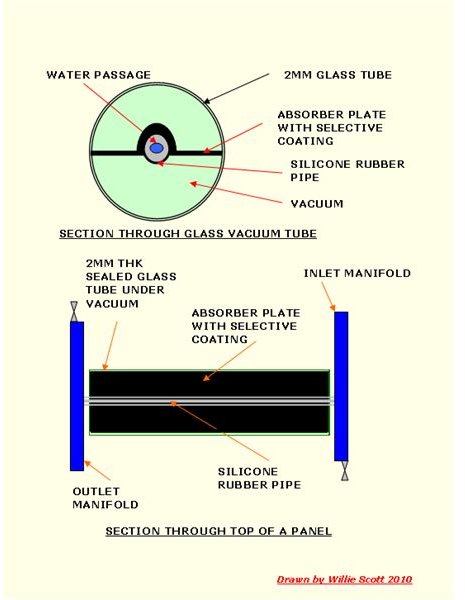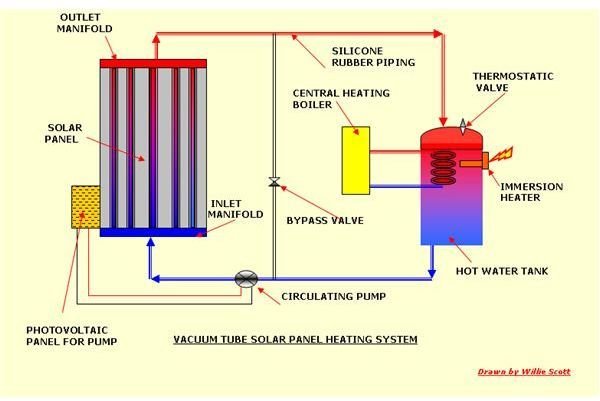Solar Engery Used to Heat Domestic Water
Solar Water Heating Panels
Introduction
Thermal solar panels are used to heat the water for domestic use in the home. The heating of the domestic water accounts for about 25% of the total heating bill. Thermal solar panels are also used to heat indoor and outdoor swimming pools.
A typical panel consists of a frame into which rows tubes are fitted and are filled with water. The water is heated by the sun and circulated by a small pump from the thermal solar panel into the top of the domestic hot water tank, returning the cooler water from the bottom of the tank back to the panel.
This is the second article on domestic use of renewable energy and in it we shall examine a modern type of thermal solar panel which uses glass vacuum tubes in place of the normal tubes, and a PV driven circulating pump.
In particular we will take a look at the following,
- Their components & operation
- Their location for optimum output
- Their supply, installation and maintenance costs
- Their payback period
- CO2 emission savings
- Comparison with conventional solar panels in relation to CO2 footprint
Vacuum Tube Thermal Solar Panel Components
The Frame
The frame which holds the tubes is fabricated from a light metal such as aluminum, into a rectangular box shape having sides and a bottom plate, which are insulated against the transfer of heat. After the installation of the components, a UV stabilized, double glazed glass cover is then bolted to the top of the frame completing the panel frame.
The Glass Tube
The glass collection tube component contains a silicon rubber pipe, laid longwise and fixed firmly to a heat absorber plate. The absorber plate runs centrally lengthwise along the glass tube not only acting as solar heat collector but also as a centralizer for the water pipe.
The heat collected by the absorber is transferred to the silicone rubber pipe through which the water is circulated.
The glass tube is then sealed leaving the pipe tails protruding and set under a permanent vacuum, effectively reducing any heat loss to the atmosphere.
A number of the glass tube components are fitted into the frame and the silicone rubber pipe tails are connected to an inlet and outlet manifold at each end of the frame. The manifolds terminate at a single inlet and outlet pipe union.
The domestic water enters the inlet pipe manifold at the bottom of the panel, rising up through the panel as it is heated to exit from the top manifold.
The Domestic Hot Water Tank
Because there is no antifreeze used in the system the hot water can be circulated through the tank and the solar panels in a direct system of heating. In the case of a solar panel using antifreeze, there had to be another coil fitted to the existing tank or a completely new hot tank with an additional copper coil fitted. This is known as an indirect system and had to be used to keep the antifreeze mixture separate from the domestic hot water.
The water from the solar panel outlet manifold enters the top of the hot water tank, the cooler water at the bottom of the tank being drawn out and pumped back to the solar panel inlet manifold.
Read on to see the orientation and installation costs, payback period and CO2 savings
Optimum Orientation and Maintenance of the Panel
Panel orientation
The panel is fitted to the roof of the dwelling, ideally facing south.
In the winter and spring the sun is very low nearer the horizon, but in the summer and autumn months it travels right across the sky enabling the panel to receive and collect more solar radiation.
The panel installation engineer will have a set of tables which will tell him the optimum angle at which the panel should be set, which is equal to the locations latitude. However he is governed by the roof angle, and usually settles for an angle of 45-60 degrees.
Maintenance of the Panel
This entails keeping the glass transparent panel clear of leaves, moss and dirt. Due to the safety implications, this is better carried out by your window cleaner every few months or so, maybe more frequently in the spring and winter months when the solar energy is at its lowest, when a clean glass plate will collect the maximum available solar radiation.
Costs, Savings and Payback Periods
Costs, Savings and Payback Periods
There are many solar panels suppliers, each one giving various payback periods, however these are very complicated and should be treated warily. A quick method of finding out the payback period for the particular panels is to collect the data listed below which should be calculated on a yearly basis. I have included a typical government Domestic Renewable Energy Grant of around 30%. This is payable on successful installation and commissioning of the solar panel by a certified installation company.
A. Projected output of energy from the solar panels (kWh)
B. Energy savings (kWh and £ sterling)
C. Initial cost of purchase and installation (£ sterling)
D. Maintenance costs (£ sterling)
E. Government grant (£ sterling)
Calculation of the payback period & CO2 savings
C+D-E/B= payback period in years
The amount of CO2 emissions saved will depend on the current system of heating,
- Oil fired boiler = 1.00kg of CO2/kWh
- Gas fired boiler = 0.75kg of CO2/kWh
- Electric Imer. = 0.90kg of CO2/kWh
Using the figure calculated at A (kWh) multiplied by the kg of CO2 emitted by type of water heating = CO2 savings/year
Using the figure calculated at A (kWh) multiplied by the kg of CO2 emitted by type of water heating = CO2 savings/year
I have prepared a table in the drawings section at the end of the article which illustrates the payback period and CO2 savings, using actual data. From this table the payback period was calculated at 12 years with annual savings of CO2 averaging 0.9Tonnes. This was based on an average price of fluctuating energy costs/kWh and a vacuum type thermal solar panel of 2.8m2 with an output between 800-1200kWh
CO2 Footprint Compared to Conventional Flat Plate Thermal Solar Panels
A Manufacturer of the type of thermal solar panel described in the article has made the following claims,
1. Their product is twice as green as the conventional thermal solar panel. - This is reportedly backed up by data given in a Bath University report (MG2008-SG-005).
2. Zero carbon solar water heating - As above backed up by same report, as the system does not use mains power, only PV supplied power
3. Competitor’s panels lose 8% of their output due to losses in piping arrangements and use of mains power - I cannot confirm the percentage, but the conventional system of piping is very inefficient being of the indirect type and, running the pump on mains will make the system less efficient.
However the above claims would appear to give vacuum thermal solar panels a good carbon footprint.
Solar Heating Panel Drawings and Calculations


